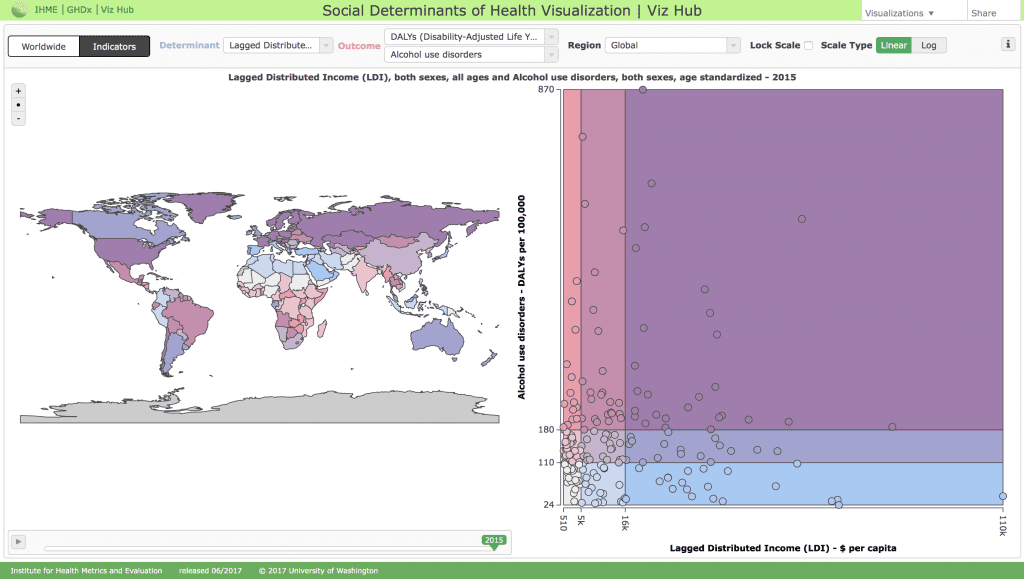New Tool: Social Determinants Of Health Visualization
About the data
The Social Determinants of Health visualization tool allows you to explore the relationships between determinants of health and health indicators across countries. This second release of the tool presents antenatal care visits, skilled birth attendance, measles and DPT3 immunization coverage, lag distributed income, and educational attainment.
Users can visualize the relationships between these determinants and life expectancy, disability-adjusted life years (DALYs) by cause, years lived with disability (YLDs) by cause, and causes of death. Additional determinants and indicators will be added to the tool in subsequent releases.

Institute for Health Metrics and Evaluation (IHME). Social Determinants of Health. Seattle, WA: IHME, University of Washington, 2017. Available from http://vizhub.healthdata.org/sdh.
About the data
Maternal mortality ratio (MMR) is defined as the number of maternal deaths per 100,000 live births. A maternal death, as opposed to a pregnancy-related death, is one for which the pregnancy is considered causal; accidental or incidental mortality is not included.
The full methods and results are described in this publication: “GBD 2015 Maternal Mortality Collaborators. Global, regional, and national levels of maternal mortality, 1990–2015: a systematic analysis for the Global Burden of Disease Study 2015. The Lancet. 2016 Oct 7; 388:1775–1812.”
Life expectancy at birth, or the expected number of years of life to be lived by a person based on mortality rates present at the time of their birth, was estimated as part of the Global Burden of Disease 2015 study (GBD 2015). Findings are published in The Lancet in the 2016 article, “Global, regional, and national life expectancy, all-cause mortality, and cause-specific mortality for 249 causes of death, 1980–2015: a systematic analysis for the Global Burden of Disease Study 2015” and provide a comprehensive assessment of all-cause and cause-specific mortality for 249 causes in 195 countries and territories from 1980 to 2015.
Healthy life expectancy (HALE) and disability-adjusted life-years (DALYs) provide summary measures of health across geographies and time that can inform assessments of epidemiological patterns and health system performance, help to prioritize investments in research and development, and monitor progress toward the Sustainable Development Goals (SDGs). GBD 2015 derived HALE and DALYs by sex for 195 countries and territories from 1990 to 2015. The findings were published in The Lancet in the 2016 article, “Global, regional, and national disability-adjusted life-years (DALYs) for 315 diseases and injuries and healthy life expectancy (HALE), 1990–2015: a systematic analysis for the Global Burden of Disease Study 2015.”
For the Global Burden of Diseases, Injuries, and Risk Factors Study 2015 (GBD 2015), the researchers at IHME estimated the incidence, prevalence, and years lived with disability for diseases and injuries at the global, regional, and national scale over the period of 1990 to 2015. Findings are published in The Lancet article, “Global, regional, and national incidence, prevalence, and years lived with disability for 310 diseases and injuries, 1990–2015: a systematic analysis for the Global Burden of Disease Study 2015.”
Using the comparative risk assessment framework developed for previous iterations of the Global Burden of Disease Study, we estimated attributable deaths, disability-adjusted life years (DALYs), and trends in exposure by age group, sex, year, and geography for 79 behavioral, environmental and occupational, and metabolic risks or clusters of risks from 1990 to 2015. The findings are published in the article, “Global, regional, and national comparative risk assessment of 79 behavioral, environmental and occupational, and metabolic risks or clusters of risks, 1990–2015: a systematic analysis for the Global Burden of Disease Study 2015.”
The Sustainable Development Goals (SDGs) specify 17 universal goals, 169 targets, and 230 indicators leading up to 2030. We provide an analysis of 33 health-related SDG indicators based on the Global Burden of Diseases, Injuries, and Risk Factors Study 2015 (GBD 2015) and published findings in The Lancet in the 2016 article, “Measuring the health-related Sustainable Development Goals in 188 countries: a baseline analysis from the Global Burden of Disease Study 2015.”
LDI is defined as lag distributed income per capita (I$): gross domestic product per capita that has been smoothed over the preceding 10 years.